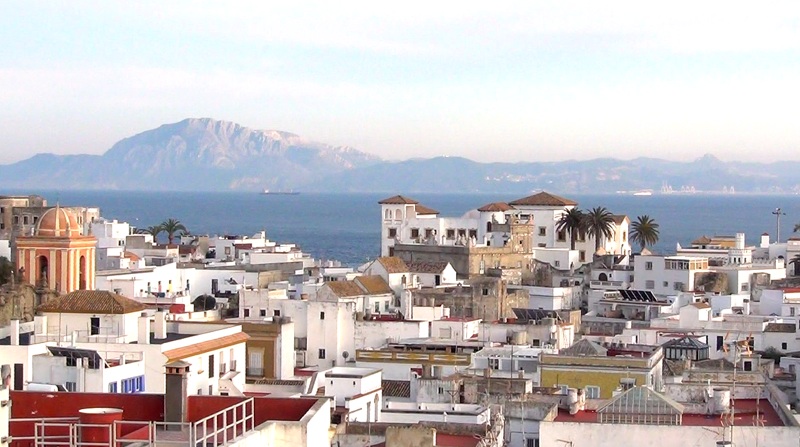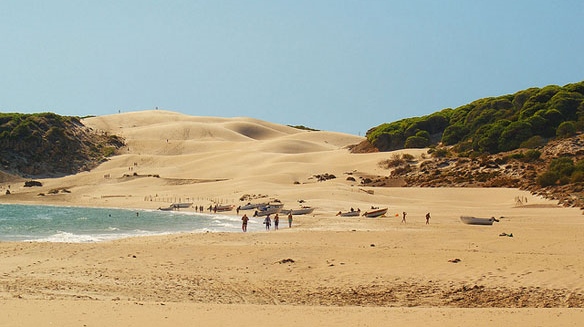 Terrific Tarifa
Terrific Tarifa
Tarifa, Baelo Claudio and Costa de la Luz
The small town of Tarifa sits at the southernmost point of Europe, with its toes in the Straits of Gibraltar and Morocco and the north coast of Africa just a stone’s throw away across the water. It is just 15km or 1 hour on one of the many daily ferries from here to hop over to Tangier. Tarifa is the windy headland where the Mediterranean Sea and Atlantic Ocean join and where European and Arabic cultures come together in a heady mix of laidback, colourful surfer-chic with a moorish twist.

Explore the maze of narrow winding streets in the old town, browse shops full of Arab trinkets or surfing gear, grab refreshments in one of the many tapas bars and restaurants. Then take a short walk from the city walls and you’ll be straight onto the beach, amid miles of glorious white sand.

The town is filled with battlements and buildings which remind us of its long history, strategic military importance and changing ownership under different regimes. Berbers, Romans, North African Islamics, Amoravids, Spanish, French and British all had a stint here. There is also plenty to do outside Tarifa's town. The wide, deep bay and steady winds throughout the year have led to the area becoming a windsurfer/kite surfer’s paradise, with holiday accommodation, surfing schools and shops selling surf gear dotted all the way up the coast. Go a little further north up this coast (the Costa de la Luz) and you will also find the ruins of the Roman city of Baelo Claudio
The beach itself is truly stunning, with abundant and beautiful white sand - it’s so much nicer than the Costa del Sol’s shallow and pebbly beaches which tend to be overcrowded at this time of year. In early June, when we visited, the weather was hot and sunny but the beach remained pretty much deserted. Maybe it’s the imperative need for a windbreak which puts off the sunbathers or it’s simply too much trouble to get there. The town is relatively remote (compared with the Malaga coast) and there isn’t a convenient motorway for miles around. Yet this is exactly why Tarifa has managed to preserve so much of its charm and character, where you are more likely to find cafes serving delicious fresh fish tapas or offering a taste of a hookah than an English breakfast!
If you are down on the beach, you should definitely take a walk up the sand dune on Punta Paloma beach. The sand has blown steadily up a wide gully between the rocks for many years and now completely buries a large expanse of pine trees – and it’s still growing. It’s a good work out to climb up the dune and there are great views down the beach from the top.

Going further north about 20 kilometres, towards the village of Bolonia, you will find the ruins of the Roman town of Baelo Claudio. The town grew out of the huge industry generated by the annual tuna migration up the Straits of Gibraltar and now the ruins sit imposingly at the water’s edge. Whilst other similar towns existed along this coast, Baelo Claudio is by far the best preserved and restored.
The tour around the remains of the town is well laid out, with good information boards in English as well as Spanish (just enough information to make it interesting without swamping you with tons of historical details). They tell the story of a thriving town dating back to the end of the 1st century BC, where catching tuna in the Straits of Gibraltar during the bi-annual migration created huge industry and wealth for the town. However I found my stomach slightly turned by the description of the great delicacy, garum, for which this town was famous. This was a delicious-sounding concoction of fermented fish, used as a condiment in top Roman cuisine. It involved salting the intestines of small fishes and then leaving them to dry in the sun for one to three months. Apparently the salt inhibited the normal process of decay and you ended up with a clear liquid (the best bit) sitting atop a base of sediment and sludge – yum! The clear liquid was then mixed with a few other bits of fish and some old wine and left in a pot in the sun for another few months. The very best garum from Baelo Claudio was made solely with the innards of the tuna, including blood and gills. Mmm-mm, I have quite an appetite!
The museum at the entry to the site is a starkly modern building, contrasting fantastically with the ruins around it. It is beautifully light and airy inside, very pleasant and cool to wander around, and the exhibits are well displayed. Our only small gripe was that, whilst there was English on all the boards about the city and its history, the boards about the tuna fishing and products they produced from the fish (that garum stuff) were only in Spanish, so you could miss out on this interesting subject.
The only other issue with Baelo Claudio is actually finding it, as there are NO road signs on the main road and the first signs only appear after you can already actually see the site itsel!! So if you are looking for it, take the N340 out of Tarifa towards Cadiz about 16km and take the turning for La Bolonia. A few kilometres up a winding country road bring you out at the beach, where you will see a couple of chiringuitos (beach cafes) and the ruins.
Back in Tarifa itself, the nightlife is quite lively. The place has quite a young feel to it and there are plenty of restaurants and nice bars. Take a wander around the old town as the light fades, stop off for a beer or copita of sherry, produced further up the coast in Jerez, and sample some of the freshest and most delicious fish in Andalucia. Watch the street life pick up and take it easy. It’s a very pleasant way to spend a warm summers’ evening.

If you'd like to see Tarifa and do some great mountain biking, we have a fabulous mountain bike tour from Ronda to Tarifa, exploring wonderful countryside, castles, sea views, forest, white villages and much much more.
Heather Cooper, Hike + Bike the Sierras 07/06/2014

